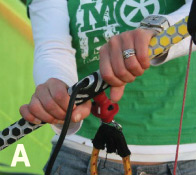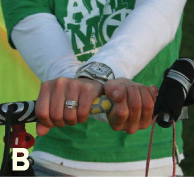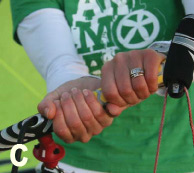F-16
F-16
WHAT IS THIS, AN AIRFORCE JET PLANE?
No, the F-16 is a fundamental nature of an unhooked back loop kite loop, a kite loop being when the kite is hurled against the direction of travel.
Its core difference from the hooked in version, or in fact the purest unhooked version is the way that you hold the bar. As we shall see both hands will be grasping onto one side of the bar, which forces the kite to turn extremely fast. This in turn means that there is very little input from the surfer once it’s all begun, and that the kite will not produce g-suit necessitating forces. A real grin and bear it move, which is well within the reach of anyone who can back loop kite loop and unhook.
ANGLING
 Pic A. Here we can see that the surfer is holding the bar with both hands centered in normal position riding to the right side.
Pic A. Here we can see that the surfer is holding the bar with both hands centered in normal position riding to the right side.
Now the surfer has two options, and it is up to you to see which you use. Knowing that you will need to get both hands on the back of the bar, you could either:
 Pic B. Leave your back hand
Pic B. Leave your back hand  where it is, let go of your front hand and move it.
where it is, let go of your front hand and move it.
Or Pic C. move your back hand down to the end of the bar, release your front hand and grab the bar just the other side of the chicken loop in front of your back hand also with your palm facing up.
Both of these procedures work, although the first one necessitates less movement. Grab your bar and straighten your arms above your head to see which feels most comfortable.
THE KITE
The kite is very much dictating what is happening in the F-16. It will pull you up, it will rotate you and it will softly drop you back down once it finishes the loop.
It is very vital to trim your kite with the center line adjustment strap so that you are in control. Bowsexuals could leave a little more power in the kite as they do tend to turn quicker.
Doing an F-16, you will need to aim and position your kite very close to 12 o’clock above you. Like other powered techniques, starting while traveling slightly downwind will help. For the F-16, there are two grounds for this, other than the fact that it will be easier to unhook.
Firstly, once you have unhooked, if the lines are not completely tight, the kite will not move swiftly as you change your hands. This is very important especially on small kites.
Secondly, you need to do the whole rotation in the air. Most of us are used to doing the first half of a back loop by carving big time into the wind, which means that we’re already turned 180 degrees before taking off. If we do this for the F-16, we will overdo the spinning process. By cruising slightly off downwind, it allows us to carve for pop without turning too much into the spin.
THE YOU
The other main ingredient to a successful F-16 is an early take off. If you wait until the kite pulls you off the water, it will already have turned too far, and therefore pull you around too early, making landing a little wobbly or leading to a bad case of over rotation.
The best thing to do is to physically jump up into your back loop off your edge just before you think the kite will pull. By doing this, you’ll aim to finish half the spin. If you can look upwind while being at the peak of your jump, the kite will take over and bring you around for a nice soft landing. However, this may take a bit of practice to get the timing.
REAL TIME
The approach for the following sequence is identical to that of the down loop s-bend. Having had a very good look around to check that the coast is clear and that you have provided yourself miles of space downwind, slowly hurl the kite up towards 12 o’clock, flatten the board off to bear off the wind slightly and unhook. As soon as you have unhooked change your hands.
1. Once the hands have moved, it’s time to get back on your edge so that you’d still have some power to pop off. Do this by dropping your weight low and getting your shoulders out and upwind of the board. The bar is now vertical, this will happen automatically.
2. Just before the kite pulls, carve hard bending the rear leg ready to pop upwards. Your head should be looking forward in an effort not to create too much rotation.
3. Pop off; jump up across the air powerfully. Keep your head equally close to your shoulders. Your aim is to do half a back loop.
4. The kite has now travelled far enough behind that it pulls up.
5. As the kite starts looping, the power will extend you. The turning of the kite should pull you around.
6. When you feel the power collapse, look over your shoulder and locate a landing spot.
7-9. Remain focused on where you expect to land. The kite will have little power, and as a result, you will drop back towards the water surface. Grab and pull the bar in towards your hips to get your legs back underneath you.
10. With your legs dropping underneath, try and focus on pointing the board downwind.
11. On landing, try and maintain your weight over the back of the board.
12. Review where the kite is. If it is not travelling forward, let it continue to loop until it is, then release you upward facing palm (original front hand), place it back on the front of the bar and then hook in.
BEST TIPS
A speedy approach will make the pull from the kite seem far less violent while it gives you more control and a smoother landing.
If the bar is getting ripped out of your hands, try not to edge too hard for too long. Go downwind a bit more.
Try to imagine the F-16 as a game of follow the leader. As the kite loops you, just follow it around one step behind.
Dropping the back hand as you come down can help slow down the spin and also makes a speedy landing a whole lot easier.
If you keep on over rotating without getting any height, try not to throw a back loop, but ease into it by jumping up.
The more power you have in the kite, the higher and harder you will go. Just take it easy when learning.
This is how it should look after some practise 🙂

Leave a Reply